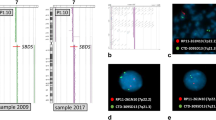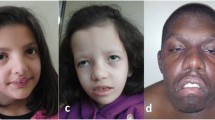Summary
Two cases of trisomy 21q223 with the Down's phenotype were analysed by in situ hybridization with specific probes previously located in the sub-bands 21q221 (SOD-A) and 21q223 (BCEI and COL6A). These studies give evidence that the clinical picture of Down's syndrome is at least to a great extent correlated with trisomy for the 21q223 band.
Similar content being viewed by others
References
Augereau P, Garcia M, Mattei MG, Cavailles V, Depadova F, Derocq D, Capony F, Ferrara P, Rochefort H (1988) Cloning and sequencing of the 52K cathepsin D complementary deoxyribonucleic acid of MCF7 breast cancer cells and mapping on chromosome 11. Mol Endocrinol 2:186–192
Aula P, Leisti J, Von Koskull H (1973) Partial trisomy 21. Clin Genet 4:241–251
Baret A, Michel P, Imbert MR, Morcellet JL, Morcellet JL, Michelson AM (1979) A radioimmunoassay for copper containing superoxide dismutase. Biochem Biophys Res Commun 88:337–345
Delabar JM, Sinet PM, Chadefaux AM, Nicole A, Gegonne A, Stehelin D, Fridlansky D, Goldberg N, Turleau C, Grouchy J de (1987) Submicroscopic duplication of chromosome 21 and trisomy 21 phenotype. Hum Genet 76:225–229
Gouvernet J, Caraboeuf ML, Aymé S (1985) GENDIAG: a computer-assisted facility in medical genetics based on belief functions. Methods Inf Med 24:177–180
Habedank M, Rodewald A (1982) Moderate Down's syndrome in three sibblings having partial trisomy 21q22.2-qter and therefore no SOD-1 excess. Hum Genet 60:74–77
Hagemeijer A, Smit EME (1977) Partial trisomy 21: further evidence that trisomy of band 21q22 is essential for Down's phenotype. Hum Genet 38:15–23
Huret JL, Delabar JM, Marlhens F, Aurias A, Nicole A, Bethier M, Tanzer J, Sinet PM (1987) Down syndrome with duplication of a region of chromosome 21 containing the CuZn superoxide dismutase gene without detectable karyotypic abnormality. Hum Genet 75:251–257
Jeziorowska A, Jakubowski L, Lach J, Kaluzewski B (1988) Regular trisomy 21 not accompanied by increased copper-zinc superoxide dismutase (SOD-1) activity. Clin Genet 33:11–19
Kedziora J, Bartorz G, Leyko W, Rosynkawa D (1979) Dismutase activity in translocation trisomy. Lancet 1:105
Kirkilionis A, Sergovich F (1986) Down syndrome with apparently normal chromosomes: an update. J Pediatr 108:793–794
Lejeune J, Gautier M, Turpin R (1959) Etude des chromosomes somatiques de 9 enfants mongoliens. C R Acad Sci Paris 248: 1721–1728
Leonard C, Gautier M, Sinet PM, Selva J, Huret JL (1986) Two Down syndrome patients with rec(21), dupq, inv(21)(p11;q2109) from a familial pericentric inversion. Ann Génét (Paris) 29:181–183
Leschot NJ, Slater RM, Joenje H, Becker-Bloemkolk MJ, De Neff JJ (1981) SOD-A and chromosome 21. Conflicting findings in a familial translocation (9p24;21q214). Hum Genet 57:220–223
Mattei JF, Mattei MG, Baeteman MA, Giraud F (1981) Trisomy 21 for the region 21q223: identification by high resolution R banding patterns. Hum Genet 56:409–411
Mattei MG, Philip N, Passage E, Moisan JP, Mandel JL, Mattei JF (1985) DNA probe localization at 18p113 band by in situ hybridization and identification of a small supernumerary chromosome. Hum Genet 69:268–271
Miyazaki K, Yamanaka T, Ogasawara N (1987) A boy with Down's syndrome having recombinant chromosome 21 but no SOD-1 excess. Clin Genet 32:383–387
Moisan JP, Mattei MG, Baeteman-Voelckel MA, Mattei JF, Brown AMC, Garnier JM, Jeltsch JM, Masiakowsky P, Roberts M, Mandel JL (1985) A gene expressed in human mammary tumor cells under estrogen control (BCEI) is located in 21q223 and defines and RFLP. Cytogenet Cell Genet 40:701–702
Niebuhr E (1974) Down syndrome: the possibility of a pathogenetic segment on chromosome 21. Humangenetik 21:99–101
Pfeiffer RA, Kessel EK, Soer KH (1977) Partial trisomies of chromosome 21 in man. Two new observations due to translocations 19;21 and 4;21. Clin Genet 11:207–213
Philip T, Fraisse J, Sinet PM, Lauras B, Robert JM, Freycon F (1978) Confirmation of the assignment of the human SOD-A gene to chromosome 21q22. Cytogenet Cell Genet 22:521–523
Poissonnier M, Saint Paul G, Dutrillaux B, Chassaigne M, Gruyer P, De Blignieres Strouk G (1976) Trisomie 21 partielle (21q21;21q222). Ann Génét (Paris) 19:69–73
Raoul O, Dutrillaux B, Carpentier S, Mallet R, Lejeune J (1976) Trisomies partielles du chromosome 21 par translocation maternelle t(15;21)(q262;q21). Ann Génét (Paris) 19:187–190
Sinet PM, Allard D, Lejeune J, Jerome H (1974) Augmentation d'activité de la superoxyde dismutase érythrocytaire dans la trisomie pour le chromosome 21. C R Acad Sci Paris 278:3267–3270
Sinet PM, Couturier J, Dutrillaux B, Poissonnier M, Raoul O, Rethore MO, Allard D, Lejeune J, Jerome H (1976) Trisome 21 et superoxyde dismutase 1 (IPO-A): tentative de localisation sur la sousbande 21q221. Exp Cell Res 97:47–55
Tan YH, Tischfield I, Ruddle FH (1973) The linkage of genes for the human interferon induced antiviral protein and indophenol oxidase B traits to chromosome 21. J Exp Med 137:317–330
Wahrman J, Goitein R, Richeler C, Goldman B, Akstein E, Chaki R (1976) The monogoloid phenotype in man is due to trisomy of the distal pale G-band of chromosome 21. In: Pearson PL, Lewis KR (eds) Chromosomes today, vol 5. Israel Universities Press, Tel Aviv, pp 241–248
Weil D, Mattei MG, Passage E, N'Guyen VC, Pribula-Conway D, Mannk, Deutzmann R, Timpl R, Chu ML, (1988) Assignment of the three genes coding for the different chains of type VI collagen (COL6A1, COL6A2, COL6A3). Cytogenet Cell Genet 46:713
Williams JD, Summitt RL, Martens PR, Kimbrell RA (1975) Familial Down syndrome due to t(10;21) translocation; evidence that the Down phenotype is related to trisomy of specific segment of chromosome 21. Am J Hum Genet 27:478–485
Yunis JJ, Sawyer JR, Ball DW (1978) The characterization of high resolution 6 banded chromosomes of man. Chromosoma 67:293–307
Author information
Authors and Affiliations
Rights and permissions
About this article
Cite this article
Pellissier, M.C., Laffage, M., Philip, N. et al. Trisomy 21q223 and Down's phenotype correlation evidenced by in situ hybridization. Hum Genet 80, 277–281 (1988). https://doi.org/10.1007/BF01790097
Received:
Revised:
Issue Date:
DOI: https://doi.org/10.1007/BF01790097




